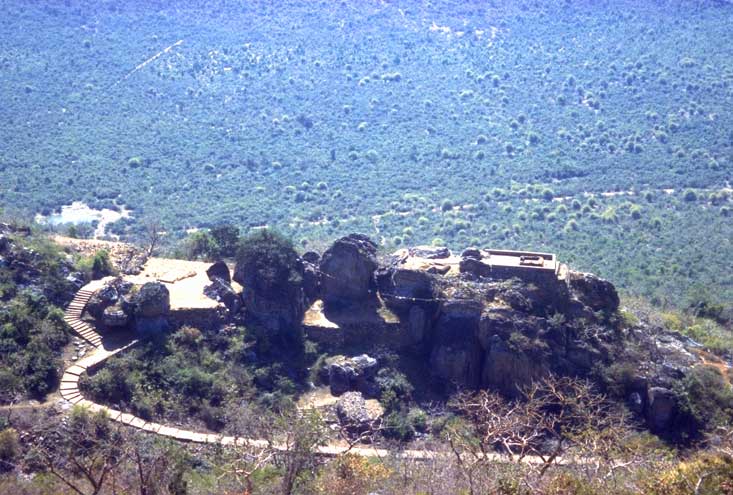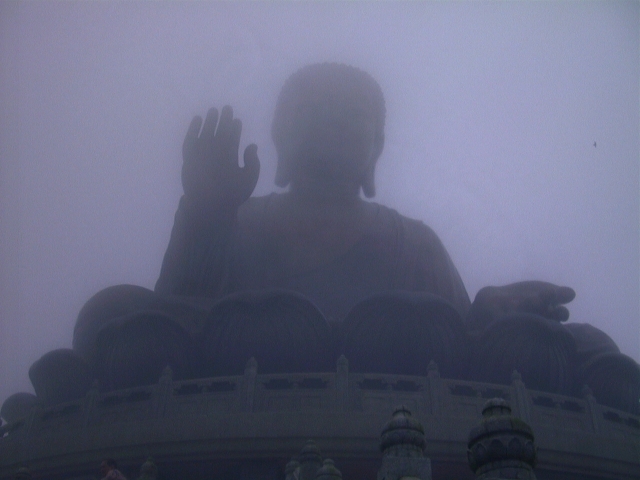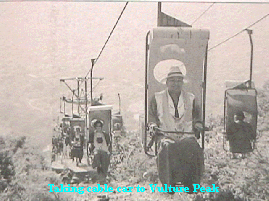
(for larger size click image then click again)

"Thus it has been said when Shakyamuni Buddha was in Grdhrakuta mountain, he twirled a flower in his finger and held it before his congregation. Everyone was silent. Only Maha Kashapa wholeheartedly smiled. Buddha said, 'I have the eye of the true teaching, the heart of Nirvana, the formless form, the mysterious gate of Dharma. Beyond the words and beyond all teachings to be transmitted, I now pass this on to Maha Kashapa.'"
One of the most important of all associations with a "place" in the life and teachings of the Buddha, other than the Bodhi Tree and Deer Park, is with Vulture Peak, a small mountain just outside the city of the ancient city of Rajgir, India. Here, sixteen years after his Enlightenment, he set forth the second turning of the wheel of Dharma to an assembly of 5,000 monks, nuns and laity, as well as innumerable bodhisattvas. This collection of teachings, which extended over twelve years, includes the Saddharmapundarika Sutra and the Surangama Samadhi Sutra, as well as many
Prajna-paramita Sutras, which, as the Buddha himself told Ananda, contain the very essence of all his teachings. Mahakashyapa recorded these latter teachings and Shakyamuni placed them in the custody of the nagas until such time as men were ready to receive them. The Prajna Paramita Sutras appeared between 200 B.C.E and 400 C.E., and considered the beginning of the Mahayana literature. There are 600 volumes in the Prajna Paramita and the Heart Sutra is the condensation, or the "heart," of all the Prajna Paramita literature. The Diamond Sutra, the Sixth Patriarch of Chinese Ch'an (Zen) Hui Neng's favorite sutra and the one attributed to his Awakening, is part of the Prajna Paramita literature as well.
The Buddha's respect for Mahakashyapa was such that when they first met, the two exchanged cloaks. Legend has it he now resides within the Gurupada Mountain near Bodhgaya. Here he awaits Maitreya, upon whom he will place the cloak of Shakyamuni.
When the Chinese pilgrims visited Vulture's Peak they found the summit green and bare. Fa Hien mentions a cave and Hsuan Chwang a hall slightly below it, where the Buddha is said to have sat and preached. Here also he once reached through the mountain with his hand to calm Ananda, whose meditation was being disturbed by Mara, in Buddhism, the lord of misfortune, who appeared in the form of a Vulture of which, because of the many inhabitants thereof, the peak is named. Before the cave were the walking and sitting places of the previous buddhas, and a stupa where the Saddharmapundarika Sutra was taught.
King Bimbisara built a causeway leading up to the hill. At the foot of the hill was Amaravana, the mango grove offered to the Buddha by the physician Jivaka. The remains of what was once a monastery may still be seen here. According to Hsuan Chwang, at one time on Vulture's Peak there was a monastery occupied by many meditators and several Arhants.
ZEN AND THE TRANSMISSION OF SPIRITUAL POWER
On the 12th of January we rode in our bus to Rajgir on pilgrimage to Mount Gridhrakuta, the Vulture Peak. Along the highway to we saw winding rock walls on the hills that stretched over 27 miles, the remains of an ancient regional defense. One by one we rode the ski lift up to the hilltop to a huge stupa built by a Japanese Buddhist group. At each of the four cardinal points was a niche on the wall halfway up the stupa. The gilded statue of Buddha, therein, commemorated the Birth, Enlightenment, Preaching and Nirvana of Sakyamuni. There was a Japanese Temple nearby. From there we walked down lower to the famous Vulture Peak. Near the top of Vulture Peak were a few caves of various sizes along the roadside. Some of the rocks at the entrance of these caves were adorned with gold leaves, and inside the large caves were relics of burnt incense or candles. Some of the main disciples of Buddha were believed to have retreated in these caves.
(please click image)
UNLIKE THE NEEDS OF NEARLY ALL OTHER LIVING CREATURES, VULTURES
DO NOT KILL. EITHER THEIR PREY DIES OR SOMETHING ELSE KILLS IT
(please click image)
The scientific name for the Turkey Vulture is CATHARTES AURA which means GOLDEN PURIFIER because as it goes about it's lifetime business it purifies the landscape and environment in it's own natural way, ensuring the continued health and life of other living things. The Vulture is a promise that all hardship was temporary and necessary for a higher purpose.
THE GOLDEN PURIFIER
In Buddhism the Golden Purifier is COMPASSION, Karuna in Sanskrit. Compassion works for us in allowing us to perceive the pain, anguish, affliction, agony, torment and distress of others clearly, through allowing it into our experience also. It is then something that has moved further out of the realm of the ignored or the unconscious into the realm of the included, the accepted, the conscious. Compassion is spacious, allowing the way things are to exist, to change, and to end. Particularly it allows pain to end. This means that it must be patient, not in any hurry to force pain to end or to try officiously to get rid of pain. It is the active side of wisdom and is the Buddha's supreme or GOLDEN PURIFIER. The Buddha's compassion allowed him to realize that there is still something that can be done by a fully Enlightened being. It was compassion that motivated him to teach "for the benefit of those with dust in their eyes".(source)
Where there is carrion lying on the ground, meat-eating birds circle and descend. Life and Death, seemingly two, become one. The living attack the dead, to their own profit. The dead lose nothing by it. They gain as well by being disposed of. Or they seem to, IF you must think in terms of gain and loss.
Do you then approach the study of Zen with the idea that there is something to be gained by it? This question is not intended as an implicit accusation. But it is , nevertheless, a serious question. Where there is a lot of fuss about "spirituality," "Enlightenment," or just "turning on" it is often because there are vultures hovering around a corpse. This hovering, this circling, this descending, this celebration of victory is not what is meant by the Study of Zen -- even though they might be highly useful exercises in other contexts. And they enrich the Birds of Appetite. Zen enriches no one. There is no body to be found. The birds may come and circle for a while in the place where it is thought to be. But they soon go elsewhere. When they are gone, the "nothing" the "no-body" that was there, suddenly appears. That is Zen. It was there all the time but the scavengers missed it, because it was not their kind of prey. (see)
--From Thomas Merton, Zen and the Birds of Appetite, ix
Fundamentally, our experience as experienced is not different from the Zen master's. Where
we differ is that we place a fog, a particular kind of conceptual overlay onto that experience
and then make an emotional investment in that overlay, taking it to be "real" in and of itself.

|


As to the subject of donations, for those of you who may be interested in doing so as it applies to the gratefulness of my works, I invariably suggest any funds be directed toward THE WOUNDED WARRIOR PROJECT and/or THE AMERICAN RED CROSS.